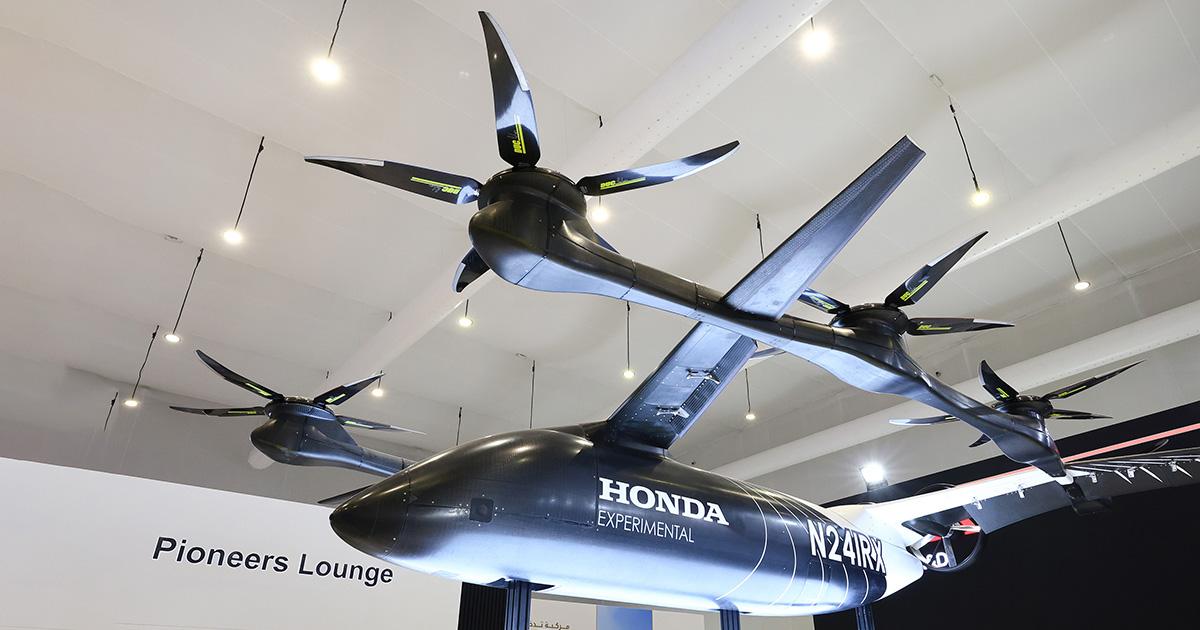|
Getting your Trinity Audio player ready...
|
Following more than 400 flights of its third-scale demonstrator, Honda is planning to fly its first full-scale eVTOL prototype in March 2026, with the build of the inaugural aircraft expected to be completed by the end of this year. The company hopes to have an FAA type certificate in hand by the early 2030s.
Although Honda has been relatively secretive about its upcoming eVTOL since announcing the program in 2021, the company’s inaugural presence at the Dubai Airshow is “good timing for us to showcase the progress of our research,” said Honda eVTOL vice president and executive chief engineer Susumu Mashio.
Joking that the company has been in so-called “stealth mode” for the last few years, Mashio explained that Honda hasn’t felt the need to “proactively announce [its progress] to the public in a very immature state.” However, the company “is now confident [its] technology is here.”
A one-third-scale technology demonstrator on display at the Dubai Airshow has been conducting a flight test campaign in California, augmenting learnings gleaned from wind tunnel testing. “This vehicle is specifically for the flight control verification,” Mashio explained. Flight profiles include forward and hovering elements, although the demonstrator has yet to complete a full transition from hover to cruise. “Because of the limitations of the vehicle, we’re confident we can achieve this transition in [the] full-scale aircraft,” he added.
The upcoming test vehicle will be remotely piloted and is set to commence flight testing in the U.S. around March 2026. Notably, the design of both the subscale demonstrator and the fuselage mockup on display has moved away from the more elliptical fuselage profiles of earlier visualizations and now includes a constant cross-section.
“It’s still in the design process, and we’re discussing which [final shape] is the right one for us,” confirmed Mashio. “It’s the combination of the design of the cabin, the aerodynamics, and also the other structural components of the vehicle that all have to come together.” The supplier list has not yet been finalized, but Honda is “watching the market,” he said.
While other competitors in the eVTOL space are increasingly looking toward hybrid powertrains for their own aircraft, Honda is a notable exception, as its eVTOL was intended to be hybrid-electric from the outset. “We are an automobile company; we know the battery technologies,” said Mashio. “When we decided to start this project, we knew that battery technology might not be there as much as we had hoped.” Although Honda wouldn’t rule out a future fully-electric aircraft variant in line with battery maturation, “for the time being, I think the hybrid systems are practical,” he said.
A hybrid-electric powertrain also presents additional FAA certification challenges, as no such aircraft has been certified so far. However, Honda is able to leverage its heritage of the HondaJet to inform lessons of critical redundancy, safety, and certification challenges from early on in its eVTOL research phase. Ultimately, the company appears not to be rushing to be among the first to commercialize its product, although conversations are ongoing with potential operators. “We need to first decide what kind of real benefit we can offer to the potential customers—that’s something we need to identify before we can make a decision to go to market,” Mashio concluded.


